qwertyuiopasdfghjklzxcvbnmqwertyuiopasdfghjklzxcvbnmqwertyuiopasd
VerifiedAdded on 2022/11/14
|6
|1968
|1
AI Summary
it an individual assignment and i have to write about Nepal. And the assessment detail you will find on assesment 3 individual essay.
Contribute Materials
Your contribution can guide someone’s learning journey. Share your
documents today.

qwertyuiopasdfghjklzxcvbnmqw
ertyuiopasdfghjklzxcvbnmqwert
yuiopasdfghjklzxcvbnmqwertyui
opasdfghjklzxcvbnmqwertyuiop
asdfghjklzxcvbnmqwertyuiopasd
fghjklzxcvbnmqwertyuiopasdfgh
jklzxcvbnmqwertyuiopasdfghjkl
zxcvbnmqwertyuiopasdfghjklzxc
vbnmqwertyuiopasdfghjklzxcvb
nmqwertyuiopasdfghjklzxcvbnm
qwertyuiopasdfghjklzxcvbnmqw
ertyuiopasdfghjklzxcvbnmqwert
yuiopasdfghjklzxcvbnmqwertyui
opasdfghjklzxcvbnmqwertyuiop
asdfghjklzxcvbnmqwertyuiopasd
fghjklzxcvbnmqwertyuiopasdfgh
jklzxcvbnmrtyuiopasdfghjklzxcv
Business ethics and sustainability
ertyuiopasdfghjklzxcvbnmqwert
yuiopasdfghjklzxcvbnmqwertyui
opasdfghjklzxcvbnmqwertyuiop
asdfghjklzxcvbnmqwertyuiopasd
fghjklzxcvbnmqwertyuiopasdfgh
jklzxcvbnmqwertyuiopasdfghjkl
zxcvbnmqwertyuiopasdfghjklzxc
vbnmqwertyuiopasdfghjklzxcvb
nmqwertyuiopasdfghjklzxcvbnm
qwertyuiopasdfghjklzxcvbnmqw
ertyuiopasdfghjklzxcvbnmqwert
yuiopasdfghjklzxcvbnmqwertyui
opasdfghjklzxcvbnmqwertyuiop
asdfghjklzxcvbnmqwertyuiopasd
fghjklzxcvbnmqwertyuiopasdfgh
jklzxcvbnmrtyuiopasdfghjklzxcv
Business ethics and sustainability
Secure Best Marks with AI Grader
Need help grading? Try our AI Grader for instant feedback on your assignments.
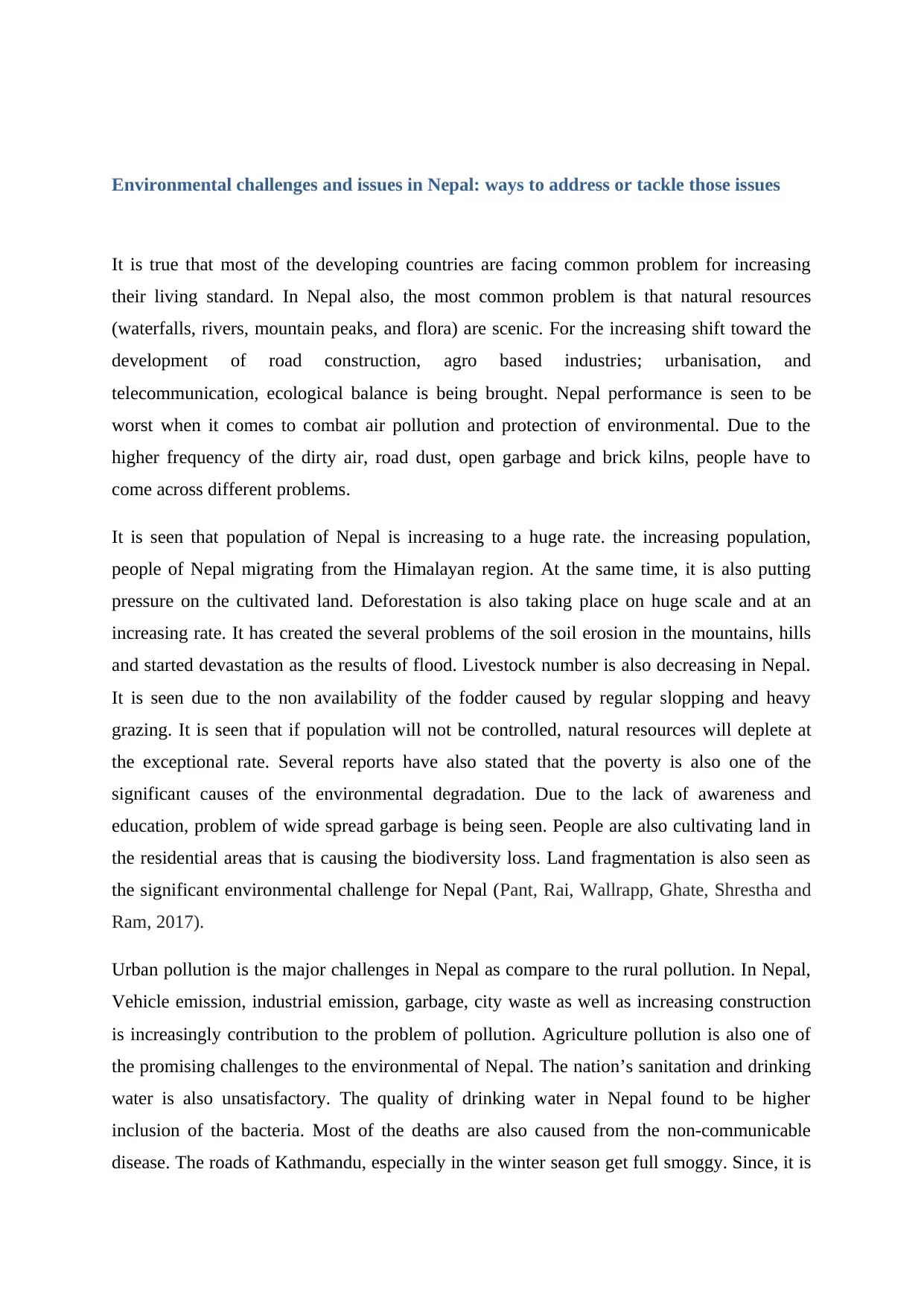
Environmental challenges and issues in Nepal: ways to address or tackle those issues
It is true that most of the developing countries are facing common problem for increasing
their living standard. In Nepal also, the most common problem is that natural resources
(waterfalls, rivers, mountain peaks, and flora) are scenic. For the increasing shift toward the
development of road construction, agro based industries; urbanisation, and
telecommunication, ecological balance is being brought. Nepal performance is seen to be
worst when it comes to combat air pollution and protection of environmental. Due to the
higher frequency of the dirty air, road dust, open garbage and brick kilns, people have to
come across different problems.
It is seen that population of Nepal is increasing to a huge rate. the increasing population,
people of Nepal migrating from the Himalayan region. At the same time, it is also putting
pressure on the cultivated land. Deforestation is also taking place on huge scale and at an
increasing rate. It has created the several problems of the soil erosion in the mountains, hills
and started devastation as the results of flood. Livestock number is also decreasing in Nepal.
It is seen due to the non availability of the fodder caused by regular slopping and heavy
grazing. It is seen that if population will not be controlled, natural resources will deplete at
the exceptional rate. Several reports have also stated that the poverty is also one of the
significant causes of the environmental degradation. Due to the lack of awareness and
education, problem of wide spread garbage is being seen. People are also cultivating land in
the residential areas that is causing the biodiversity loss. Land fragmentation is also seen as
the significant environmental challenge for Nepal (Pant, Rai, Wallrapp, Ghate, Shrestha and
Ram, 2017).
Urban pollution is the major challenges in Nepal as compare to the rural pollution. In Nepal,
Vehicle emission, industrial emission, garbage, city waste as well as increasing construction
is increasingly contribution to the problem of pollution. Agriculture pollution is also one of
the promising challenges to the environmental of Nepal. The nation’s sanitation and drinking
water is also unsatisfactory. The quality of drinking water in Nepal found to be higher
inclusion of the bacteria. Most of the deaths are also caused from the non-communicable
disease. The roads of Kathmandu, especially in the winter season get full smoggy. Since, it is
It is true that most of the developing countries are facing common problem for increasing
their living standard. In Nepal also, the most common problem is that natural resources
(waterfalls, rivers, mountain peaks, and flora) are scenic. For the increasing shift toward the
development of road construction, agro based industries; urbanisation, and
telecommunication, ecological balance is being brought. Nepal performance is seen to be
worst when it comes to combat air pollution and protection of environmental. Due to the
higher frequency of the dirty air, road dust, open garbage and brick kilns, people have to
come across different problems.
It is seen that population of Nepal is increasing to a huge rate. the increasing population,
people of Nepal migrating from the Himalayan region. At the same time, it is also putting
pressure on the cultivated land. Deforestation is also taking place on huge scale and at an
increasing rate. It has created the several problems of the soil erosion in the mountains, hills
and started devastation as the results of flood. Livestock number is also decreasing in Nepal.
It is seen due to the non availability of the fodder caused by regular slopping and heavy
grazing. It is seen that if population will not be controlled, natural resources will deplete at
the exceptional rate. Several reports have also stated that the poverty is also one of the
significant causes of the environmental degradation. Due to the lack of awareness and
education, problem of wide spread garbage is being seen. People are also cultivating land in
the residential areas that is causing the biodiversity loss. Land fragmentation is also seen as
the significant environmental challenge for Nepal (Pant, Rai, Wallrapp, Ghate, Shrestha and
Ram, 2017).
Urban pollution is the major challenges in Nepal as compare to the rural pollution. In Nepal,
Vehicle emission, industrial emission, garbage, city waste as well as increasing construction
is increasingly contribution to the problem of pollution. Agriculture pollution is also one of
the promising challenges to the environmental of Nepal. The nation’s sanitation and drinking
water is also unsatisfactory. The quality of drinking water in Nepal found to be higher
inclusion of the bacteria. Most of the deaths are also caused from the non-communicable
disease. The roads of Kathmandu, especially in the winter season get full smoggy. Since, it is
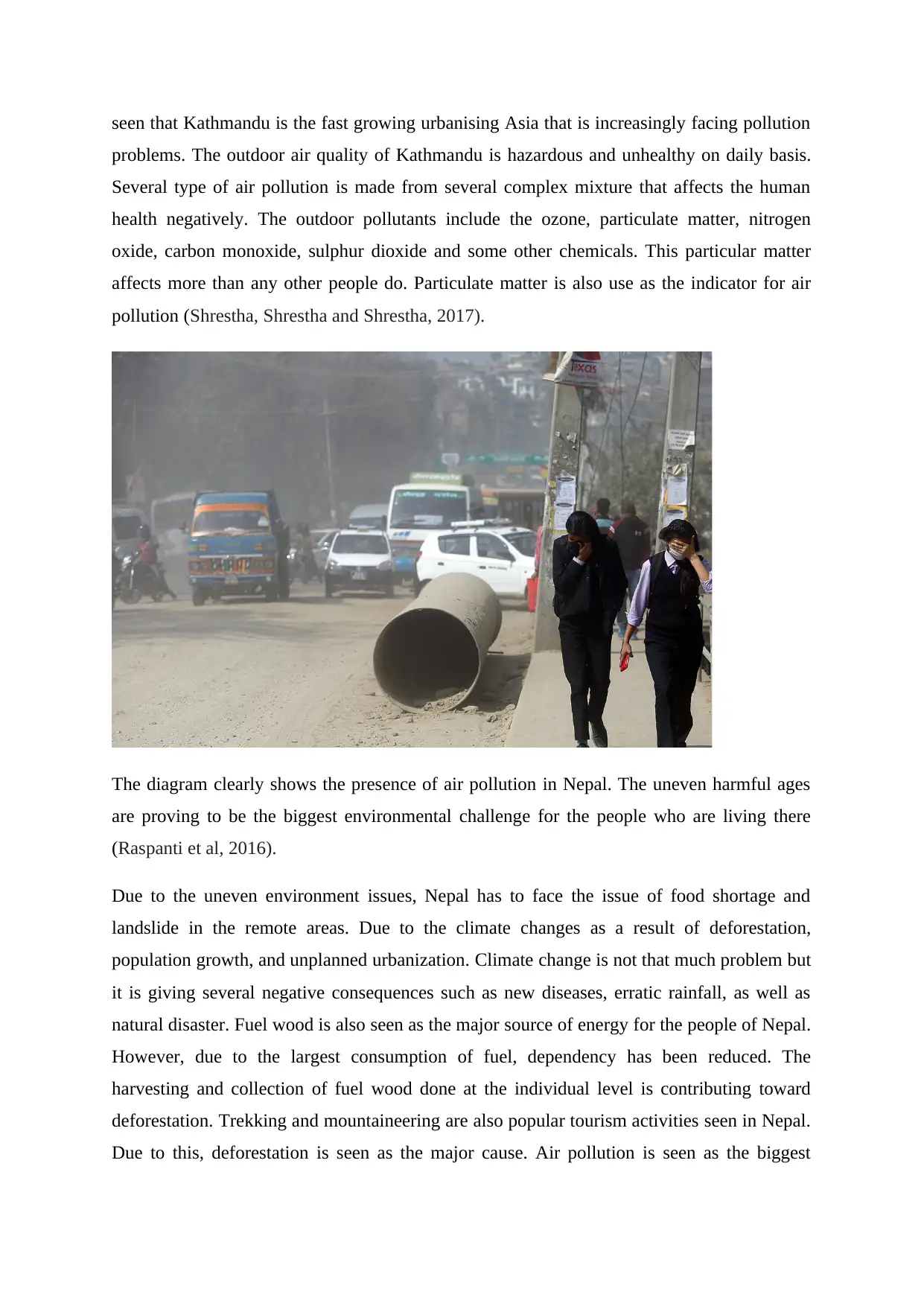
seen that Kathmandu is the fast growing urbanising Asia that is increasingly facing pollution
problems. The outdoor air quality of Kathmandu is hazardous and unhealthy on daily basis.
Several type of air pollution is made from several complex mixture that affects the human
health negatively. The outdoor pollutants include the ozone, particulate matter, nitrogen
oxide, carbon monoxide, sulphur dioxide and some other chemicals. This particular matter
affects more than any other people do. Particulate matter is also use as the indicator for air
pollution (Shrestha, Shrestha and Shrestha, 2017).
The diagram clearly shows the presence of air pollution in Nepal. The uneven harmful ages
are proving to be the biggest environmental challenge for the people who are living there
(Raspanti et al, 2016).
Due to the uneven environment issues, Nepal has to face the issue of food shortage and
landslide in the remote areas. Due to the climate changes as a result of deforestation,
population growth, and unplanned urbanization. Climate change is not that much problem but
it is giving several negative consequences such as new diseases, erratic rainfall, as well as
natural disaster. Fuel wood is also seen as the major source of energy for the people of Nepal.
However, due to the largest consumption of fuel, dependency has been reduced. The
harvesting and collection of fuel wood done at the individual level is contributing toward
deforestation. Trekking and mountaineering are also popular tourism activities seen in Nepal.
Due to this, deforestation is seen as the major cause. Air pollution is seen as the biggest
problems. The outdoor air quality of Kathmandu is hazardous and unhealthy on daily basis.
Several type of air pollution is made from several complex mixture that affects the human
health negatively. The outdoor pollutants include the ozone, particulate matter, nitrogen
oxide, carbon monoxide, sulphur dioxide and some other chemicals. This particular matter
affects more than any other people do. Particulate matter is also use as the indicator for air
pollution (Shrestha, Shrestha and Shrestha, 2017).
The diagram clearly shows the presence of air pollution in Nepal. The uneven harmful ages
are proving to be the biggest environmental challenge for the people who are living there
(Raspanti et al, 2016).
Due to the uneven environment issues, Nepal has to face the issue of food shortage and
landslide in the remote areas. Due to the climate changes as a result of deforestation,
population growth, and unplanned urbanization. Climate change is not that much problem but
it is giving several negative consequences such as new diseases, erratic rainfall, as well as
natural disaster. Fuel wood is also seen as the major source of energy for the people of Nepal.
However, due to the largest consumption of fuel, dependency has been reduced. The
harvesting and collection of fuel wood done at the individual level is contributing toward
deforestation. Trekking and mountaineering are also popular tourism activities seen in Nepal.
Due to this, deforestation is seen as the major cause. Air pollution is seen as the biggest
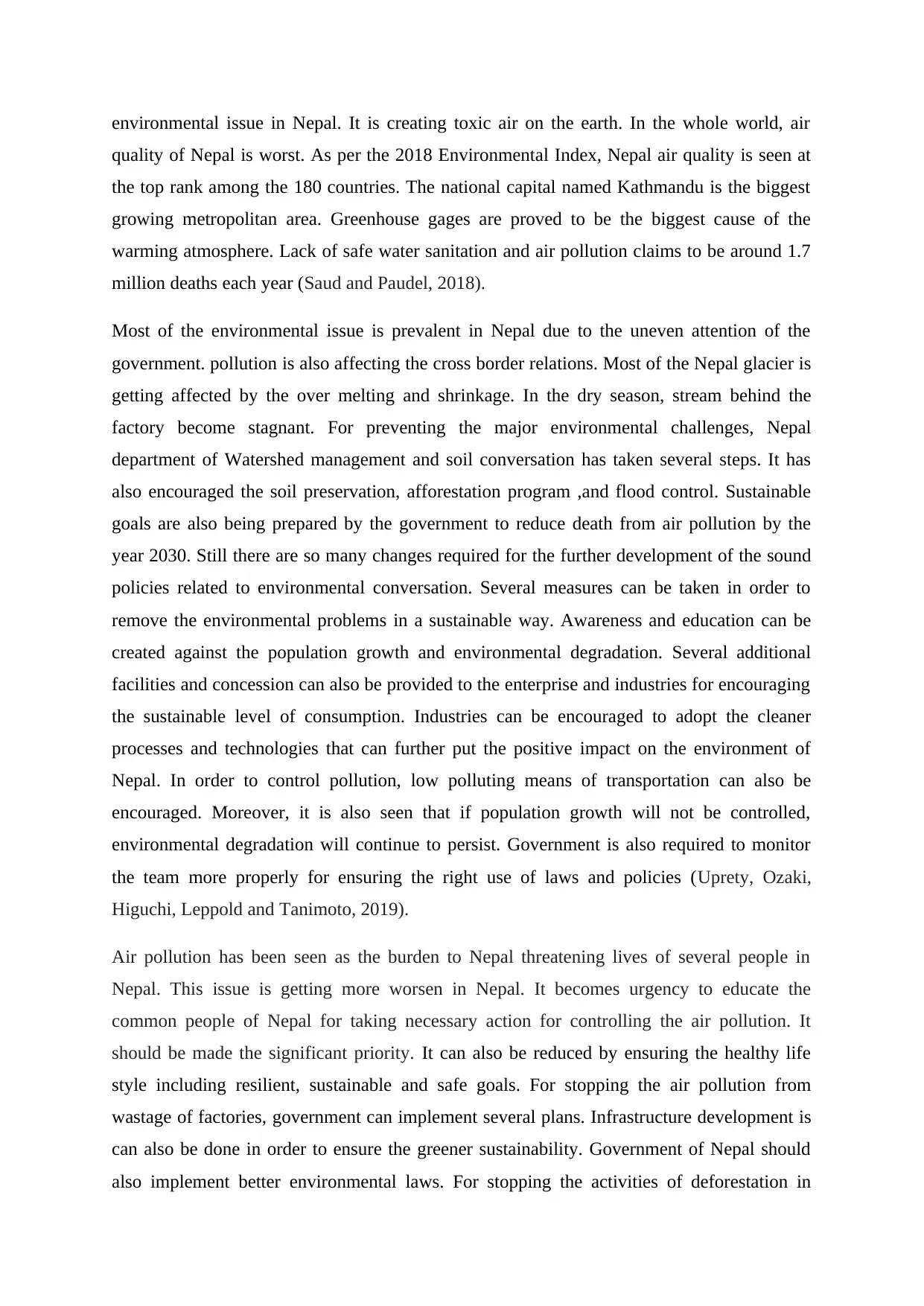
environmental issue in Nepal. It is creating toxic air on the earth. In the whole world, air
quality of Nepal is worst. As per the 2018 Environmental Index, Nepal air quality is seen at
the top rank among the 180 countries. The national capital named Kathmandu is the biggest
growing metropolitan area. Greenhouse gages are proved to be the biggest cause of the
warming atmosphere. Lack of safe water sanitation and air pollution claims to be around 1.7
million deaths each year (Saud and Paudel, 2018).
Most of the environmental issue is prevalent in Nepal due to the uneven attention of the
government. pollution is also affecting the cross border relations. Most of the Nepal glacier is
getting affected by the over melting and shrinkage. In the dry season, stream behind the
factory become stagnant. For preventing the major environmental challenges, Nepal
department of Watershed management and soil conversation has taken several steps. It has
also encouraged the soil preservation, afforestation program ,and flood control. Sustainable
goals are also being prepared by the government to reduce death from air pollution by the
year 2030. Still there are so many changes required for the further development of the sound
policies related to environmental conversation. Several measures can be taken in order to
remove the environmental problems in a sustainable way. Awareness and education can be
created against the population growth and environmental degradation. Several additional
facilities and concession can also be provided to the enterprise and industries for encouraging
the sustainable level of consumption. Industries can be encouraged to adopt the cleaner
processes and technologies that can further put the positive impact on the environment of
Nepal. In order to control pollution, low polluting means of transportation can also be
encouraged. Moreover, it is also seen that if population growth will not be controlled,
environmental degradation will continue to persist. Government is also required to monitor
the team more properly for ensuring the right use of laws and policies (Uprety, Ozaki,
Higuchi, Leppold and Tanimoto, 2019).
Air pollution has been seen as the burden to Nepal threatening lives of several people in
Nepal. This issue is getting more worsen in Nepal. It becomes urgency to educate the
common people of Nepal for taking necessary action for controlling the air pollution. It
should be made the significant priority. It can also be reduced by ensuring the healthy life
style including resilient, sustainable and safe goals. For stopping the air pollution from
wastage of factories, government can implement several plans. Infrastructure development is
can also be done in order to ensure the greener sustainability. Government of Nepal should
also implement better environmental laws. For stopping the activities of deforestation in
quality of Nepal is worst. As per the 2018 Environmental Index, Nepal air quality is seen at
the top rank among the 180 countries. The national capital named Kathmandu is the biggest
growing metropolitan area. Greenhouse gages are proved to be the biggest cause of the
warming atmosphere. Lack of safe water sanitation and air pollution claims to be around 1.7
million deaths each year (Saud and Paudel, 2018).
Most of the environmental issue is prevalent in Nepal due to the uneven attention of the
government. pollution is also affecting the cross border relations. Most of the Nepal glacier is
getting affected by the over melting and shrinkage. In the dry season, stream behind the
factory become stagnant. For preventing the major environmental challenges, Nepal
department of Watershed management and soil conversation has taken several steps. It has
also encouraged the soil preservation, afforestation program ,and flood control. Sustainable
goals are also being prepared by the government to reduce death from air pollution by the
year 2030. Still there are so many changes required for the further development of the sound
policies related to environmental conversation. Several measures can be taken in order to
remove the environmental problems in a sustainable way. Awareness and education can be
created against the population growth and environmental degradation. Several additional
facilities and concession can also be provided to the enterprise and industries for encouraging
the sustainable level of consumption. Industries can be encouraged to adopt the cleaner
processes and technologies that can further put the positive impact on the environment of
Nepal. In order to control pollution, low polluting means of transportation can also be
encouraged. Moreover, it is also seen that if population growth will not be controlled,
environmental degradation will continue to persist. Government is also required to monitor
the team more properly for ensuring the right use of laws and policies (Uprety, Ozaki,
Higuchi, Leppold and Tanimoto, 2019).
Air pollution has been seen as the burden to Nepal threatening lives of several people in
Nepal. This issue is getting more worsen in Nepal. It becomes urgency to educate the
common people of Nepal for taking necessary action for controlling the air pollution. It
should be made the significant priority. It can also be reduced by ensuring the healthy life
style including resilient, sustainable and safe goals. For stopping the air pollution from
wastage of factories, government can implement several plans. Infrastructure development is
can also be done in order to ensure the greener sustainability. Government of Nepal should
also implement better environmental laws. For stopping the activities of deforestation in
Secure Best Marks with AI Grader
Need help grading? Try our AI Grader for instant feedback on your assignments.
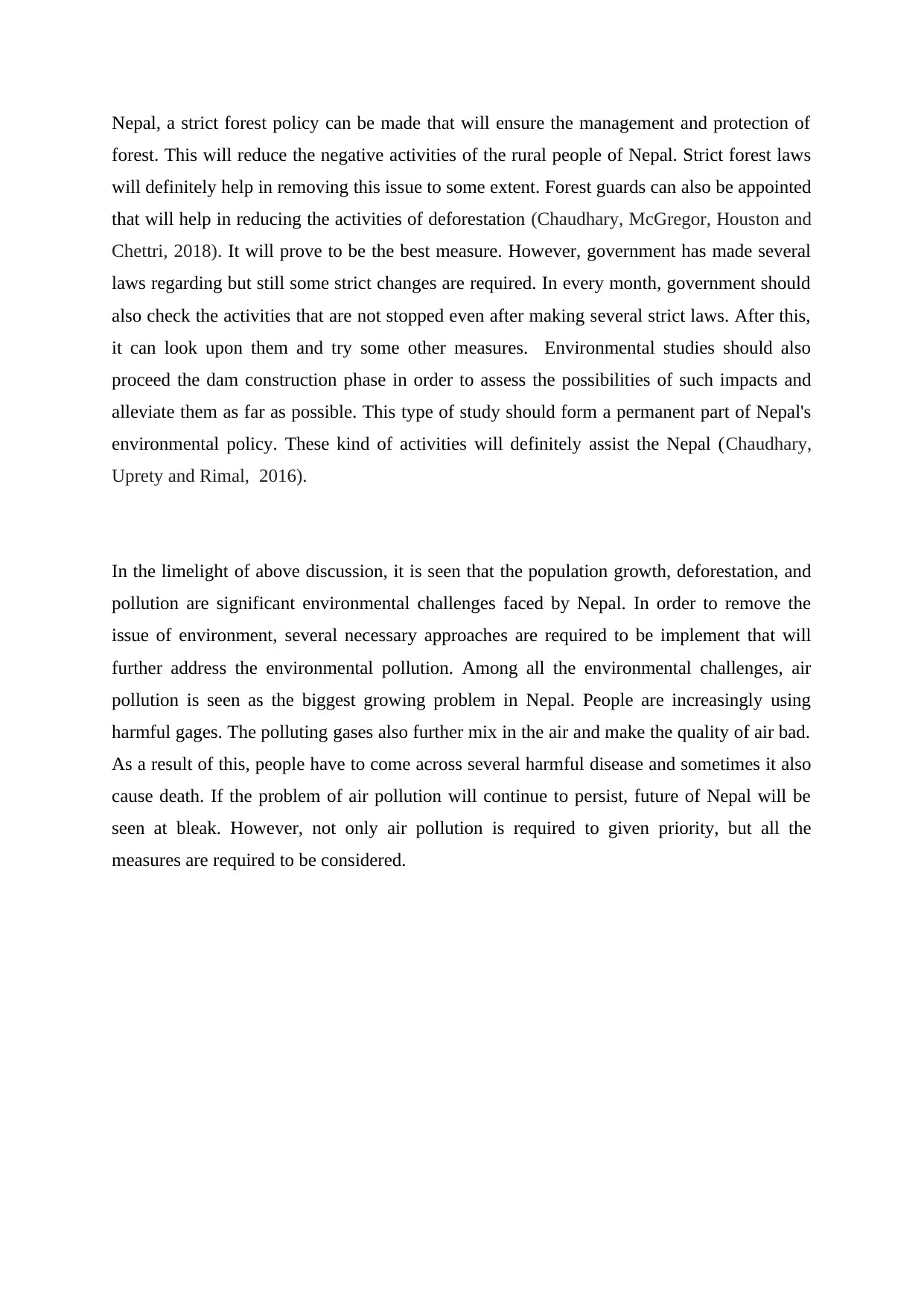
Nepal, a strict forest policy can be made that will ensure the management and protection of
forest. This will reduce the negative activities of the rural people of Nepal. Strict forest laws
will definitely help in removing this issue to some extent. Forest guards can also be appointed
that will help in reducing the activities of deforestation (Chaudhary, McGregor, Houston and
Chettri, 2018). It will prove to be the best measure. However, government has made several
laws regarding but still some strict changes are required. In every month, government should
also check the activities that are not stopped even after making several strict laws. After this,
it can look upon them and try some other measures. Environmental studies should also
proceed the dam construction phase in order to assess the possibilities of such impacts and
alleviate them as far as possible. This type of study should form a permanent part of Nepal's
environmental policy. These kind of activities will definitely assist the Nepal (Chaudhary,
Uprety and Rimal, 2016).
In the limelight of above discussion, it is seen that the population growth, deforestation, and
pollution are significant environmental challenges faced by Nepal. In order to remove the
issue of environment, several necessary approaches are required to be implement that will
further address the environmental pollution. Among all the environmental challenges, air
pollution is seen as the biggest growing problem in Nepal. People are increasingly using
harmful gages. The polluting gases also further mix in the air and make the quality of air bad.
As a result of this, people have to come across several harmful disease and sometimes it also
cause death. If the problem of air pollution will continue to persist, future of Nepal will be
seen at bleak. However, not only air pollution is required to given priority, but all the
measures are required to be considered.
forest. This will reduce the negative activities of the rural people of Nepal. Strict forest laws
will definitely help in removing this issue to some extent. Forest guards can also be appointed
that will help in reducing the activities of deforestation (Chaudhary, McGregor, Houston and
Chettri, 2018). It will prove to be the best measure. However, government has made several
laws regarding but still some strict changes are required. In every month, government should
also check the activities that are not stopped even after making several strict laws. After this,
it can look upon them and try some other measures. Environmental studies should also
proceed the dam construction phase in order to assess the possibilities of such impacts and
alleviate them as far as possible. This type of study should form a permanent part of Nepal's
environmental policy. These kind of activities will definitely assist the Nepal (Chaudhary,
Uprety and Rimal, 2016).
In the limelight of above discussion, it is seen that the population growth, deforestation, and
pollution are significant environmental challenges faced by Nepal. In order to remove the
issue of environment, several necessary approaches are required to be implement that will
further address the environmental pollution. Among all the environmental challenges, air
pollution is seen as the biggest growing problem in Nepal. People are increasingly using
harmful gages. The polluting gases also further mix in the air and make the quality of air bad.
As a result of this, people have to come across several harmful disease and sometimes it also
cause death. If the problem of air pollution will continue to persist, future of Nepal will be
seen at bleak. However, not only air pollution is required to given priority, but all the
measures are required to be considered.
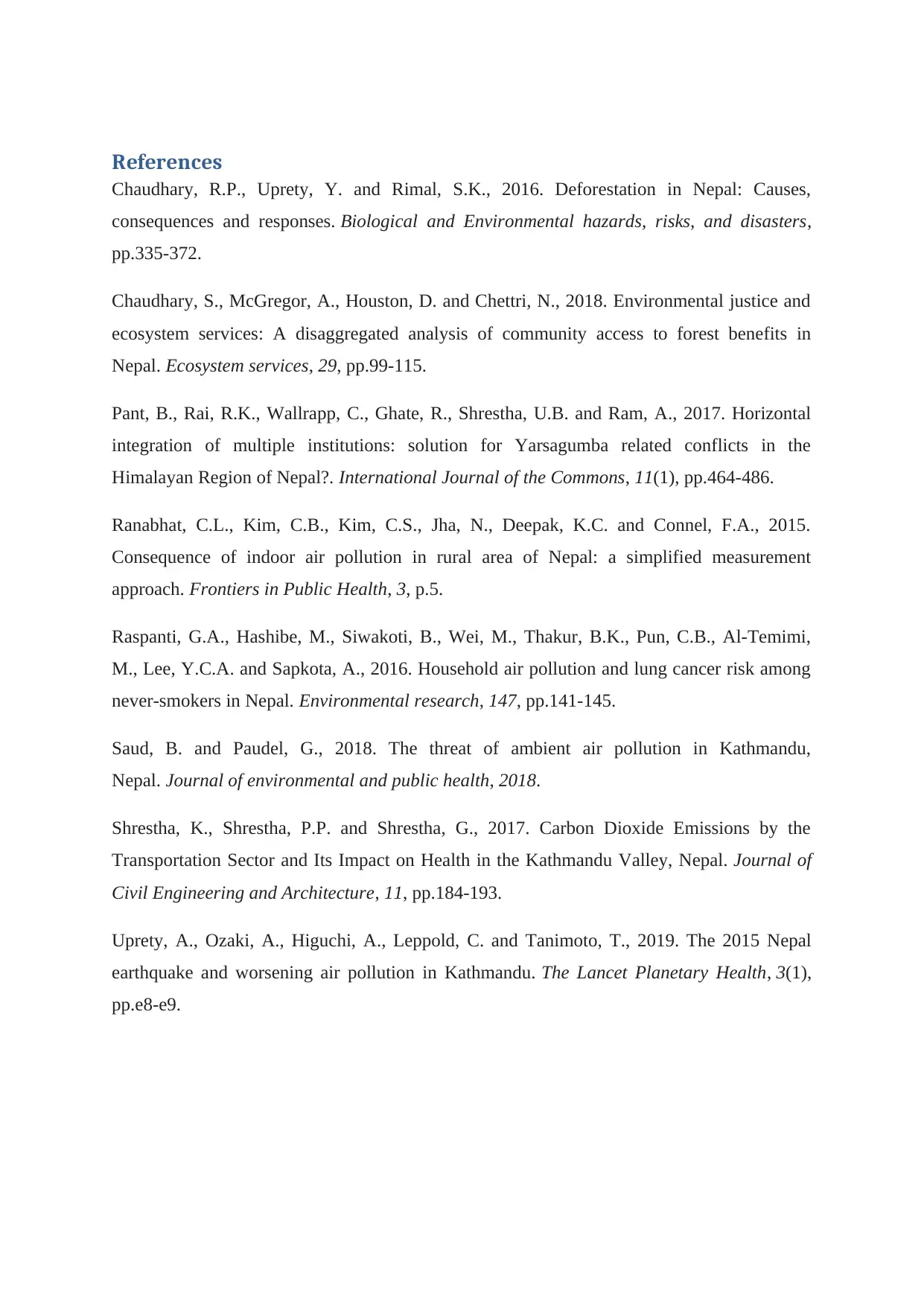
References
Chaudhary, R.P., Uprety, Y. and Rimal, S.K., 2016. Deforestation in Nepal: Causes,
consequences and responses. Biological and Environmental hazards, risks, and disasters,
pp.335-372.
Chaudhary, S., McGregor, A., Houston, D. and Chettri, N., 2018. Environmental justice and
ecosystem services: A disaggregated analysis of community access to forest benefits in
Nepal. Ecosystem services, 29, pp.99-115.
Pant, B., Rai, R.K., Wallrapp, C., Ghate, R., Shrestha, U.B. and Ram, A., 2017. Horizontal
integration of multiple institutions: solution for Yarsagumba related conflicts in the
Himalayan Region of Nepal?. International Journal of the Commons, 11(1), pp.464-486.
Ranabhat, C.L., Kim, C.B., Kim, C.S., Jha, N., Deepak, K.C. and Connel, F.A., 2015.
Consequence of indoor air pollution in rural area of Nepal: a simplified measurement
approach. Frontiers in Public Health, 3, p.5.
Raspanti, G.A., Hashibe, M., Siwakoti, B., Wei, M., Thakur, B.K., Pun, C.B., Al-Temimi,
M., Lee, Y.C.A. and Sapkota, A., 2016. Household air pollution and lung cancer risk among
never-smokers in Nepal. Environmental research, 147, pp.141-145.
Saud, B. and Paudel, G., 2018. The threat of ambient air pollution in Kathmandu,
Nepal. Journal of environmental and public health, 2018.
Shrestha, K., Shrestha, P.P. and Shrestha, G., 2017. Carbon Dioxide Emissions by the
Transportation Sector and Its Impact on Health in the Kathmandu Valley, Nepal. Journal of
Civil Engineering and Architecture, 11, pp.184-193.
Uprety, A., Ozaki, A., Higuchi, A., Leppold, C. and Tanimoto, T., 2019. The 2015 Nepal
earthquake and worsening air pollution in Kathmandu. The Lancet Planetary Health, 3(1),
pp.e8-e9.
Chaudhary, R.P., Uprety, Y. and Rimal, S.K., 2016. Deforestation in Nepal: Causes,
consequences and responses. Biological and Environmental hazards, risks, and disasters,
pp.335-372.
Chaudhary, S., McGregor, A., Houston, D. and Chettri, N., 2018. Environmental justice and
ecosystem services: A disaggregated analysis of community access to forest benefits in
Nepal. Ecosystem services, 29, pp.99-115.
Pant, B., Rai, R.K., Wallrapp, C., Ghate, R., Shrestha, U.B. and Ram, A., 2017. Horizontal
integration of multiple institutions: solution for Yarsagumba related conflicts in the
Himalayan Region of Nepal?. International Journal of the Commons, 11(1), pp.464-486.
Ranabhat, C.L., Kim, C.B., Kim, C.S., Jha, N., Deepak, K.C. and Connel, F.A., 2015.
Consequence of indoor air pollution in rural area of Nepal: a simplified measurement
approach. Frontiers in Public Health, 3, p.5.
Raspanti, G.A., Hashibe, M., Siwakoti, B., Wei, M., Thakur, B.K., Pun, C.B., Al-Temimi,
M., Lee, Y.C.A. and Sapkota, A., 2016. Household air pollution and lung cancer risk among
never-smokers in Nepal. Environmental research, 147, pp.141-145.
Saud, B. and Paudel, G., 2018. The threat of ambient air pollution in Kathmandu,
Nepal. Journal of environmental and public health, 2018.
Shrestha, K., Shrestha, P.P. and Shrestha, G., 2017. Carbon Dioxide Emissions by the
Transportation Sector and Its Impact on Health in the Kathmandu Valley, Nepal. Journal of
Civil Engineering and Architecture, 11, pp.184-193.
Uprety, A., Ozaki, A., Higuchi, A., Leppold, C. and Tanimoto, T., 2019. The 2015 Nepal
earthquake and worsening air pollution in Kathmandu. The Lancet Planetary Health, 3(1),
pp.e8-e9.
1 out of 6
Related Documents
Your All-in-One AI-Powered Toolkit for Academic Success.
+13062052269
info@desklib.com
Available 24*7 on WhatsApp / Email
![[object Object]](/_next/static/media/star-bottom.7253800d.svg)
Unlock your academic potential
© 2024 | Zucol Services PVT LTD | All rights reserved.





